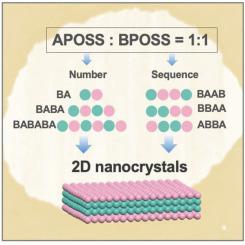This paper describes the two-dimensional (2D) crystallization of side-chain giant molecules (SCGMs) having the fixed number ratio of two types of functionalized building blocks with 1:1. SCGMs are regarded to a certain degree as size-amplified versions of universal synthetic polymers that are prepared by precisely connecting molecular nanoparticles (MNPs) to polymer chains. Our previous experimental results have shown that individually changing the number ratio of one of the building blocks would significantly affect the structural parameters of molecular crystals, mainly the longitudinal thickness. Herein, we systematically discussed the 2D crystallization of two categories of POSS-based SCGMs with constant building blocks ratio. Solution self-assembly of such SCGMs resulted in well-defined 2D nanosheets with similar structural configurations, showing great tolerance in the number of building blocks. Subsequently, we proposed a “sandwiched-type” mode to illustrate the bilayer 2D supramolecular framework, in which crystalline blocks pack in head-to-head manner. In addition, sequence isomers provide an ideal platform to further verify that the thickness of 2D nanocrystal is linked with the tethering density determined by the number ratio of building blocks. We believe that this study could be a better complement to our previous work and then make us to be more in-depth understand the crystallization mechanism of SCGMs.

| 公司名称 | 产品信息 | 采购帮参考价格 | |
|---|---|---|---|
| 百灵威 | triethylamine |
|
¥20.00~¥15112.83 |


